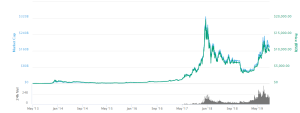Understanding Bitcoin’s Price Volatility
Unravel the mysteries of Bitcoin’s volatile price! This guide explores the key factors influencing Bitcoin’s dramatic swings, helping you navigate the crypto market with confidence. Learn the secrets behind the price fluctuations and make informed decisions.
Bitcoin‚ the world’s first cryptocurrency‚ has captivated investors and technology enthusiasts alike. Its decentralized nature and potential for disruption have made it a fascinating asset. However‚ its price is notoriously volatile‚ swinging wildly in short periods. Understanding the factors influencing Bitcoin’s price is crucial for anyone considering investing in or using this digital currency. This comprehensive guide delves into the complexities of Bitcoin’s price movements‚ exploring various economic‚ technological‚ and regulatory influences. We aim to provide a clear and insightful analysis‚ equipping you with the knowledge to navigate the dynamic world of Bitcoin pricing.
The Intricacies of Bitcoin’s Value
Unlike traditional currencies backed by governments‚ Bitcoin’s value is derived from a combination of factors‚ including supply and demand‚ market sentiment‚ technological advancements‚ regulatory changes‚ and macroeconomic conditions. These interacting forces create a complex interplay that drives price volatility. A deep understanding of each of these components is key to deciphering the sometimes-unpredictable price swings. Let’s explore these contributing factors in more detail.
Supply and Demand Dynamics
The fundamental principle of supply and demand governs Bitcoin’s price‚ just like any other asset. The limited supply of Bitcoin—capped at 21 million coins—creates scarcity. As demand increases‚ either due to increased adoption or speculation‚ the price tends to rise. Conversely‚ if demand falls‚ the price can plummet. This simple yet powerful dynamic is the cornerstone of Bitcoin’s price fluctuations.
Several factors influence demand. Increased adoption by businesses and institutions leads to higher demand‚ pushing the price upwards. Conversely‚ negative news‚ regulatory uncertainty‚ or a general market downturn can reduce demand‚ leading to price drops. The interplay between these forces constantly shapes the Bitcoin price landscape.
Market Sentiment and Speculation
Market sentiment plays a significant role in Bitcoin’s price. Positive news‚ such as successful technological upgrades or positive statements from influential figures‚ can boost investor confidence‚ leading to price increases. Conversely‚ negative news‚ such as security breaches or regulatory crackdowns‚ can trigger sell-offs and price declines. Speculation‚ driven by anticipation of future price movements‚ can also amplify these effects‚ creating significant volatility.
Social media trends and news coverage significantly influence market sentiment. Positive media portrayals can generate excitement and attract new investors‚ while negative narratives can fuel fear and uncertainty‚ leading to price drops. This highlights the importance of critical analysis and information verification before making investment decisions.
Technological Advancements and Upgrades
Technological advancements within the Bitcoin ecosystem can significantly impact its price. Successful upgrades to the Bitcoin network‚ such as improvements in scalability or security‚ can increase investor confidence and drive price appreciation. Conversely‚ delays or setbacks in technological development can lead to uncertainty and potential price drops.
The continuous development and improvement of the Bitcoin network are crucial for its long-term sustainability and adoption. Positive developments usually attract more users and businesses‚ thereby increasing demand and potentially pushing the price higher. Conversely‚ technological setbacks can trigger concerns about the network’s stability and security‚ potentially leading to a decrease in price.
Regulatory Landscape and Government Policies
Government regulations and policies concerning Bitcoin can significantly affect its price. Favorable regulations‚ such as clear guidelines for cryptocurrency exchanges or tax policies that encourage investment‚ can boost investor confidence and drive price increases. Conversely‚ restrictive regulations or outright bans can lead to uncertainty and price declines.
The regulatory landscape varies significantly across different countries. Countries with supportive regulatory frameworks often see increased Bitcoin adoption and higher prices‚ while countries with restrictive policies may experience the opposite. This global variation in regulatory approaches creates further complexity in predicting Bitcoin’s price.
Macroeconomic Factors and Global Events
Macroeconomic factors and global events can also influence Bitcoin’s price. Periods of economic uncertainty or instability can drive investors towards Bitcoin as a safe haven asset‚ increasing its demand and price. Conversely‚ positive economic news or a stable global environment may reduce the demand for Bitcoin as a safe haven‚ leading to price declines.
Global events‚ such as geopolitical tensions or major economic shifts‚ can also significantly impact investor sentiment and thus Bitcoin’s price. During times of uncertainty‚ Bitcoin’s perceived decentralization and independence from traditional financial systems can make it an attractive investment option‚ driving up demand.
Factors Affecting Bitcoin’s Price Volatility
Bitcoin’s price volatility is a defining characteristic. Several factors contribute to this inherent instability. Understanding these factors is crucial for navigating the market effectively.
- Market Manipulation: The relatively small market capitalization of Bitcoin compared to traditional assets makes it susceptible to manipulation by large investors or whales.
- News and Media Hype: Positive or negative news coverage can drastically influence investor sentiment and consequently‚ the price.
- Regulatory Uncertainty: Changes in regulations or lack of clarity around legal frameworks can create volatility.
- Technological Issues: Network upgrades‚ security breaches‚ or scaling problems can impact price movements.
- Economic Conditions: Global economic downturns or uncertainties can increase Bitcoin’s volatility as it’s considered a risk asset.
Strategies for Navigating Bitcoin’s Price Fluctuations
Given Bitcoin’s volatility‚ informed strategies are essential. Successful navigation requires careful planning and risk management.
- Diversification: Don’t put all your eggs in one basket. Diversify your investment portfolio to mitigate risk.
- Dollar-Cost Averaging (DCA): Invest a fixed amount of money at regular intervals‚ regardless of price fluctuations.
- Long-Term Perspective: Bitcoin’s price is volatile in the short term‚ but many believe in its long-term potential.
- Risk Tolerance Assessment: Understand your personal risk tolerance before investing in Bitcoin.
- Stay Informed: Keep up-to-date with news‚ technological developments‚ and regulatory changes affecting Bitcoin.
Understanding Your Risk Tolerance
Before investing in Bitcoin‚ it is crucial to assess your risk tolerance. Bitcoin’s price can fluctuate dramatically‚ leading to significant gains or losses. Investors with a high risk tolerance may be comfortable with the potential for large price swings‚ while those with a low risk tolerance may prefer to avoid such volatile assets altogether. A thorough understanding of your personal risk profile is paramount in making informed investment decisions. Carefully consider your financial situation and your ability to withstand potential losses before venturing into the Bitcoin market.
The Importance of Due Diligence
Conducting thorough due diligence before investing in Bitcoin is crucial. This involves researching the technology behind Bitcoin‚ understanding its potential risks and rewards‚ and staying informed about regulatory developments. It also involves carefully choosing a reputable cryptocurrency exchange and taking necessary security measures to protect your investments. Thorough research and a cautious approach can significantly mitigate potential risks and enhance the likelihood of successful investment outcomes.






